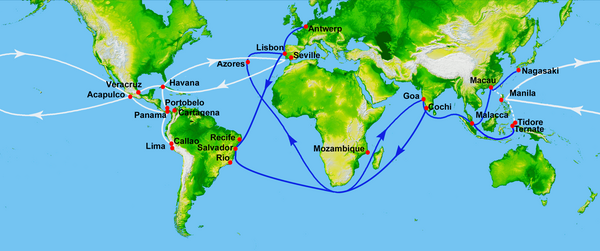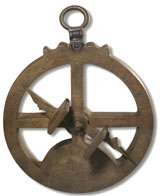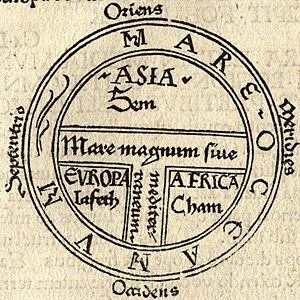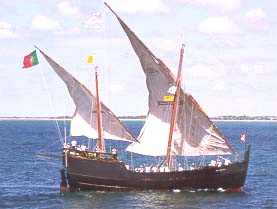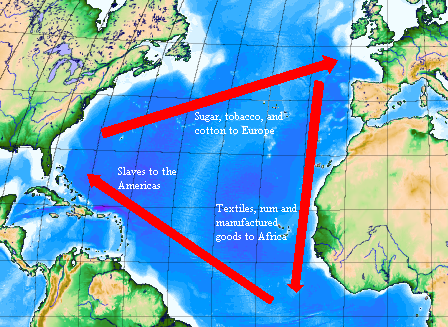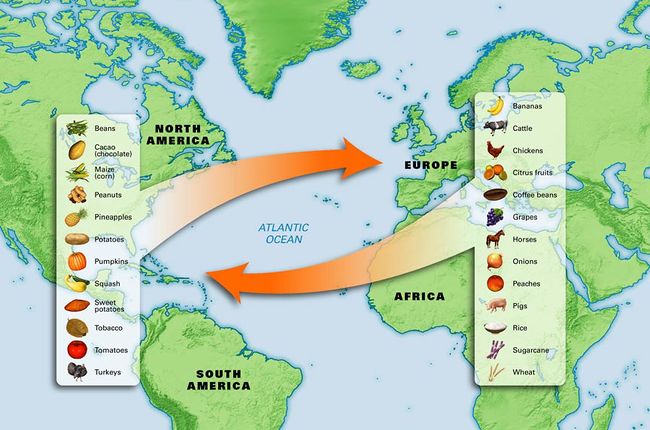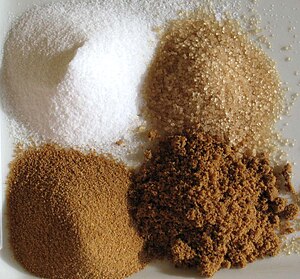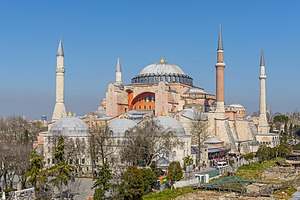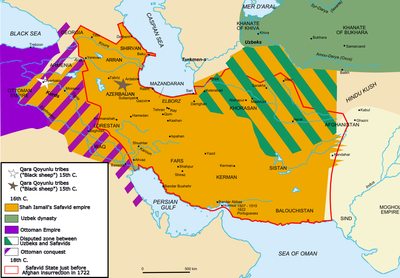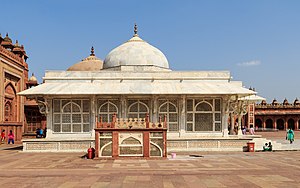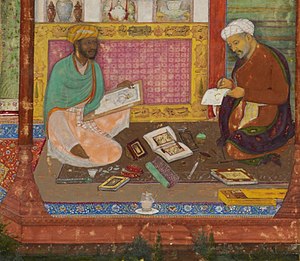Key Concept 4.1 Globalizing Networks of Communication and Exchange
Jump to navigation
Jump to search
One of most important features of this time period (1450-1750) is the integration of both hemispheres into the world's first truly global network of trade. New technologies and methods of financing enabled trans-Atlantic trade and altered previous patterns of exchange. The ensuring new encounters spread culture, religion, new foods, and disease across the globe. Demographic changes were volatile, with some areas experiencing drastic changes because of the introduction of new foods while other areas, such as the Americas, were devastated with the introduction of new diseases.
- I. In the context of the new global circulation of goods, there was in intensification of all existing regional trade networks that brought prosperity and economic disruption to the merchants and governments in the trading regions of the Indian Ocean, Mediterranean, Sahara, and overland Eurasia.
- The voyage of Columbus inaugurated a network of global trade that connected both hemispheres. Silver from the New World was minted into the peso de ocho, a widely accepted currency that connected major trade systems. In the Pacific, the Spanish colony of Manila connected the New World with Asia markets; much of the New World's silver ended up in China. Despite this new level of global connectivity, this era saw major disruptions and changes in trade networks. Attempts by Portugal and Spain to monopolize trade in the Indian Ocean led to the down fall of the Swahili cities and the fall of Malacca. In Africa, the incorporation of West Africa into the Atlantic system drew the focus of trade from Trans-Saharan to the west. The fall of Constantinople to the Muslim Ottomans and Vasco DaGama’s maritime route to the Indian Ocean lessened Europe’s dependence upon Silk Road trade. The Atlantic System would emerge as the premier trade system in this era.
- The voyage of Columbus inaugurated a network of global trade that connected both hemispheres. Silver from the New World was minted into the peso de ocho, a widely accepted currency that connected major trade systems. In the Pacific, the Spanish colony of Manila connected the New World with Asia markets; much of the New World's silver ended up in China. Despite this new level of global connectivity, this era saw major disruptions and changes in trade networks. Attempts by Portugal and Spain to monopolize trade in the Indian Ocean led to the down fall of the Swahili cities and the fall of Malacca. In Africa, the incorporation of West Africa into the Atlantic system drew the focus of trade from Trans-Saharan to the west. The fall of Constantinople to the Muslim Ottomans and Vasco DaGama’s maritime route to the Indian Ocean lessened Europe’s dependence upon Silk Road trade. The Atlantic System would emerge as the premier trade system in this era.
- II. European technological developments in cartography and navigation built on previous knowledge developed in the classical, Islamic, and Asian worlds.
- The most significant change in global trade between 1450 and 1750 was the rise and involvement of the Europeans. Beginning with Portugal and Spain, European countries would commission the exploration, charting, and colonization of a huge portion of the world. The advancements that enabled them to do this, however, did not originate in a vacuum. Europeans adapted, improved, and synthesized the use of technologies and knowledge deriving from many cultures.
- Navigation Technologies Islamic civilization had long possessed the need for astronomical and geographic knowledge. Muslims schools were expected to pronounce daily prayer times, calculate the exact time of the holy month of Ramadan, and provide the faithful with the direction of Mecca for the purpose of prayer. To address these religious matters they developed the astrolabe which enabled them to solve "300 types of problems in astronomy, geography, and trigonometry." [1] Through Muslim Spain, the astrolabe entered Christian Europe. Borrowing the basic principles of the Islamic astrolabe, the Portuguese created the mariner's astrolabe, an instrument whose functions were limited to and designed specifically for the purpose of navigation. At sea, the mariner's astrolabe helped ships determine their latitude by aligning the instrument with the sun or a known star.
- Cartography The sea voyages of the Europeans in this era could not have taken place without a revolution in the craft of cartography, or map making. European maps in the Middle Ages, called T-O maps because of their shape, were not intended as tools for navigation. These maps often placed Jerusalem in the center of the world and divided the world into the domains of Noah's three sons. Hence they were qualitative maps intended to make a religious statement about the world from a Christian point of view. They declared what was religiously important but were useless in bringing sailors back to port. [2]
- Navigation Technologies Islamic civilization had long possessed the need for astronomical and geographic knowledge. Muslims schools were expected to pronounce daily prayer times, calculate the exact time of the holy month of Ramadan, and provide the faithful with the direction of Mecca for the purpose of prayer. To address these religious matters they developed the astrolabe which enabled them to solve "300 types of problems in astronomy, geography, and trigonometry." [1] Through Muslim Spain, the astrolabe entered Christian Europe. Borrowing the basic principles of the Islamic astrolabe, the Portuguese created the mariner's astrolabe, an instrument whose functions were limited to and designed specifically for the purpose of navigation. At sea, the mariner's astrolabe helped ships determine their latitude by aligning the instrument with the sun or a known star.
- This changed with European contacts with Byzantine and Islamic influences that had been increasing over the previous few centuries. Although writings of the Greek cartographer Ptolemy (90-168 C.E.) had been making their way into Europe in the previous period, few Europeans read Greek. With the increase of available classical authors and their translation into Latin, a new interest in Ptolemy's work emerged. [3] Combined with the growing desire for trade, navigation and cartography attracted some of the best academic minds of the 15th century who began to view the world, like Ptolemy, in a quantitative way.[4] They believed mathematics corresponded with the actual way the world was.[5] A change in mentality meant that the world was now conceived in a mathematical and rational way. Cartography was concerned with making maps that resemble the features of geography as they actually existed rather than making a theological statement about the world. Merchants could now use maps to plot new routes to and from desired locations and their experiences and information was in turn applied to the latest maps. The craft of this new quantitative method of map-making and the training required for the new instruments of navigation were taught in the city of Lisbon, Portugal.
- Innovations in Ship Design Another European advancement based on previous technologies was the caravel, a light, fast, and maneuverable ship first devised by the Portuguese. (Columbus constantly praised his favorite ship, the Niña which along with the Pinta seemed to be a caravel.[6]) Lighter, requiring a smaller crew, and able to carry more cargo than the typical oar-driven Mediterranean ships, [7] the caravel adopted the lateen sail first pioneered by Arab merchants in the India Ocean. This gave these ships the ability to tack into the face of the wind. The caravel was able to carry a large cargo with an inordinately small crew, thus decreasing the cost of shipping and increasing profits. Developing about a century after the caravel was the Spanish galleon, a large multi-deck ship with at least three or four masts. The forward sails were large rectangular power sails with the last mast usually carrying a lateen sail. These ships were the primary vessels of the Spanish Treasure Fleet and were capable of carrying an enormous volume of cargo. They carried most of the slaves across the Atlantic via the dreaded Middle Passage. Europeans were the first to mount firearms on their ships, outfitting their caravels and galleons with broadside canon. Thus armed, these ships gave Europeans the capacity to project unprecedented power.
- Knowledge of Wind and Sea Currents Europeans were also aided by their growing familiarity with the global environment and their adaptation to it. The Portuguese learned that the most efficient maritime route between two points is not always a strait line. This could involve fighting the wind and sea currents. Consequently, they developed a strategy known as the volta do mar, or turn of the sea. Often going far out of their way, the Portuguese and other European sailors learned instead to work with the currents. For example, when Vasco da Gama sought a route to the Indian Ocean around Africa, he sailed nearly to the coast of Brazil before he caught the westerlies that took him around the Cape of Good Hope at the southern tip of Africa.[8] Knowledge of such trade winds allowed sailors to be more efficient by using, rather than going against, the grain of nature.
- Innovations in Ship Design Another European advancement based on previous technologies was the caravel, a light, fast, and maneuverable ship first devised by the Portuguese. (Columbus constantly praised his favorite ship, the Niña which along with the Pinta seemed to be a caravel.[6]) Lighter, requiring a smaller crew, and able to carry more cargo than the typical oar-driven Mediterranean ships, [7] the caravel adopted the lateen sail first pioneered by Arab merchants in the India Ocean. This gave these ships the ability to tack into the face of the wind. The caravel was able to carry a large cargo with an inordinately small crew, thus decreasing the cost of shipping and increasing profits. Developing about a century after the caravel was
- The most significant change in global trade between 1450 and 1750 was the rise and involvement of the Europeans. Beginning with Portugal and Spain, European countries would commission the exploration, charting, and colonization of a huge portion of the world. The advancements that enabled them to do this, however, did not originate in a vacuum. Europeans adapted, improved, and synthesized the use of technologies and knowledge deriving from many cultures.
- III. Remarkable new transoceanic maritime reconnaissance occurred in this period.
- A. Unaffected by the ravages of Europe's 100 Years War and Spain's civil strife, Portugal became the first European nation to embark on a program of exploration. King John's son, Prince Henry, was motivated by a crusading zeal to convert heathens to Christianity and an economic zeal to gain access to west Africa's legendary sources of gold. Henry's capture of the Muslim city of Ceuta in 1415 opened the western coast of Africa to Portuguese exploration, and by the year of Henry's death in 1460 his country had arrived in Guinea on Africa's western coast. Soon African gold was flowing by sea from west Africa directly to Iberia rather than across the trans-Saharan caravan routes. Algiers and Tunis in north Africa were economically devastated by this rerouting of trade. Portugal got rich. [9] As contacts with west African societies continued the Portuguese began trading in ivory and slaves as well.
- After a dispute with his father, Prince Henry returned home to Portugal but avoided the capital of Lisbon where he could have easily gained a comfortable royal job. Instead, he settled in the remove coastal town of Sagres which he turned into a center of navigational studies and cartography. Now called Prince Henry the Navigator, he collected fresh information from newly arrived sailors to produce the most current maps possible. The compass, thought by many Europeans to be driven my occult powers, was disenchanted of superstition and its use expanded and refined. Since initial Portuguese voyages traveled north and south exploring Africa, more precise means of measuring latitude were researched. Borrowing elements of Arabic shipbuilding, Prince Henry and his engineers designed the famous caravel, mentioned above. All the elements needed for global exploration were brought together by Prince Henry at Sagres. Portugal was poised to take the lead, albeit brief, in the exploration and exploitation of the globe. [10]
- Equipped with new maritime instruments and knowledge, the Portuguese accomplished many "firsts" in global exploration. In 1487 Bartholomew Diaz sailed his caravel around the southern tip of Africa, the first European to do so (his crew refused to press on to India). Then Vasco da Gama became the first to sail all the way to India in 1498; Europeans had found the illusive water route to the lucrative Indian Ocean trade network. The Portuguese strategy in the Indian Ocean was to dominate trade through the use of firepower, intimidation, and brutality. In the long run they were never able to completely monopolize this network but did succeed in building a trading-post empire which gave them a significant share of the spice and slave trade. With over 50 trading posts from southeast Asia to Africa's west coast, they attempted to force merchants to call at these ports and pay duties. They also required merchants to purchase passports from them; sailors caught at sea without one were mutilated and had their cargo confiscated. Despite these grand plans, the Portuguese had neither the manpower nor the fleet to carry out their demands. Many Indian Ocean merchants took their chances and sailed without passports or paying dues at Portuguese trading-posts. And the Spanish, English and Dutch sailors hired by the Portuguese to work their fleet took the knowledge of the seas back to their respective countries who were organizing their own expeditions to Asia. [11] The Portuguese began the explorations but were soon to be strong-armed out of the way by their European neighbors.
- A. Unaffected by the ravages of Europe's 100 Years War and Spain's civil strife, Portugal became the first European nation to embark on a program of exploration. King John's son, Prince Henry, was motivated by a crusading zeal to convert heathens to Christianity and an economic zeal to gain access to west Africa's legendary sources of gold. Henry's capture of the Muslim city of Ceuta in 1415 opened the western coast of Africa to Portuguese exploration, and by the year of Henry's death in 1460 his country had arrived in
- B. In 1476 a 25 year old Christopher Columbus washed onto the Portuguese shore with a broken oar he had used as a float. The cargo ship he worked on had been sunk by a French fleet near Gibraltar. As fortune would have it, the place where he reached the shore was only a few miles from Sagres, the location of Prince Henry's research center of navigation and cartography. Having grown up in Genoa on the Italian coast, Columbus had long possessed a fascination with sailing. But his time in Portugal, particularly Lisbon, would prove to be the most formative for what he would unwittingly accomplish.
- The idea that sailing west would led one to Asia was not new. What was novel about Columbus was his conviction that the distance between Europe and Asia to the west was not significant. Basing his argument on Marco Polo's description of the distance across Eurasia and Ptolemy's longitudinal calculations, Columbus vastly underestimated the distance of a western route to Asia. Nevertheless, he set out enthusiastically to convince the monarchs of Europe he was right in order to obtain funding for his journey. After a series of rejections, Ferdinand and Isabella of newly united Spain decided to pay for Columbus' voyage. In October of 1492 he sighted land in what he believed to be Asia. Columbus would make four voyages across the Atlantic and seems to have died not knowing that he had failed.
- Columbus did not actually discover anything, nor was he the first European to make this crossing. Nonetheless, his journey is very important historically because he initiated a world-transforming encounter between two hemispheres of this planet. There would be profound cultural, demographic, political and social consequences.
- C. When it was realized that Columbus had not succeeded in finding a route to Asia, the quest did not end. North Atlantic crossings increased as European explorers sought to exploit the wealth of the New World and continue to find a way across it. The waters off the eastern coast of North America were teeming with fish and some men made fortunes shipping salt-cured cod to Europe and the Caribbean. [12] Explorers such as Champlain from France earned huge profits by sending beaver pelts back to Europe. But like many others, Champlain's motivation was not merely conquest or profit for their own sake. The furs were used to fund his ongoing obsession--the discovery of a western route to China. [13]
- B. In 1476 a 25 year old Christopher Columbus washed onto the Portuguese shore with a broken oar he had used as a float. The cargo ship he worked on had been sunk by a French fleet near Gibraltar. As fortune would have it, the place where he reached the shore was only a few miles from Sagres, the location of Prince Henry's research center of navigation and cartography. Having grown up in Genoa on the Italian coast, Columbus had long possessed a fascination with sailing. But his time in Portugal, particularly Lisbon, would prove to be the most formative for what he would unwittingly accomplish.
- IV. The new global circulation of goods was facilitated by royal chartered European monopoly companies that took silver from Spanish colonies in the Americas to purchase Asian goods for the Atlantic markets, but regional markets continued to flourish in Afro-Eurasia by using established commercial practices and new transoceanic shipping services developed by European merchants.
- A. According to the long standing conventions of Indian Ocean trade, no single power controlled the entire network and the seas were free and open to any merchant. The Europeans would attempt to change this. Beginning with the Portuguese, Europeans attempted to install a Mediterranean system of trade which used military might to divert trade through trading ports they controlled. There it could be taxed. [14] They did not really bring any items of their own to trade, or add value to the sum of trade in this region. Instead, they attempted, in a parasitic way, to extract benefits from the host network into which they forced themselves.
- From the start, superior firepower allowed them to accomplish much. The Portuguese stormed the Swahili city of Kilwa and threw out its Muslim leaders. Commander Alfonso Alboquerque seized Malacca in 1511 (the Dutch would take it from Portugal in 1641). The Portuguese attempted to close the Red Sea to trade to stop this "leak" of trade through their fingers into the Mediterranean via Egypt. Breaking traditional customs of tolerance, the King of Portugal asked the leader of Calicut to expel all Muslims from his kingdom. But Portugal's ambitions were grander than its ability to enforce its demands. Rather than an all-out conquest of the region, they established a trading-post empire (mentioned above) in order to profit from goods as they moved from one area to another. Indeed, by the end of the 1500s they had integrated with the normal political and economic climate of the region. [15] Other European countries would implement the same strategy. The Dutch, for example, found that working within the existing system could produce for them the highest profits. They made a fortune charging fees to transport items from one Asian area to another. [16] The European powers were never able to establish genuine and lasting monopolies in the Indian Ocean. This is in stark contrast with their experiences in the New World.
- B. We saw in the previous period (600-1450) that the creation of a common currency in China facilitated trade in that region. Widely accepted currencies speed up transactions and provide standardized way for merchants to measure the value of products. In this period the use of a common currency expanded from regional to global use. The Spanish peso de ocho, or "piece of eight," was the first currency in history to be used globally.
- This currency was the product of Spain's mining of enormous amounts of silver in the New World. In present day Bolivia and Mexico, they discovered massive deposits of silver, including a mountain full of silver at Potosi. After the purest veins of silver were quickly strip-mined production slowed; then the Spanish introduced the amalgamation method of using mercury to extract silver from ore. Production soared. In two centuries the silver mines of the Spanish New World produced 40,000 tons of silver. [17] The industrial centers that grew around these mines minted 2.5 million silver coins per year. The peso de ocho, worth about 80 US dollars today, gained acceptance around the world and lubricated global trade on an unprecedented level. Mughal India wanted Spanish silver for payment for its pepper sales, and this surge of silver funded Shah Jahan's construction of the Taj Mahal. Much of the Spanish silver ended up the hands of the Chinese, who had no desire for European products but readily accepted silver as payment for its coveted exports. The peso do ocho was even accepted currency in the United States until the Coinage Act of 1857. [18]
- C. In the early 1600s European countries found new methods of financing exploration and business. Since trading ventures were too expensive for most individuals to fund, investors began to pool their resources together into organizations called joint-stock companies. The most famous of these, the British East India Company (EIC), began in 1600 when the British government gave 218 London investors a royal monopoly of all trade east of the Cape of Good Hope. Established about one year later was the Dutch East India Company, known as the VOC. They were initially a much larger and wealthier rival of the EIC, with 10 times the capital resources of its British counterpart. Joint-stock companies proliferated. The Dutch West Indies Company traded in the New World and founded New Amsterdam, today New York City. And the Virginia Company of London was given a monopoly on the mid-Atlantic coast of North America.
- Joint-stock companies were an improvement over traditional partnerships because of something called limited liability. In a partnership, investors pool their resources together and share the profits or losses collectively. In the case of a shipwreck or some other calamity, however, investors would owe more than they put in and could be driven to bankruptcy. But the limited liability of a joint-stock company meant that an investor could never lose more than what he paid in. With risks thus limited but the potential for profit still high, joint-stock companies attracted thousands of investors willing to put up money, called stock, in these ventures.
- Voyages funded by joint-stock companies were more efficient and profitable than those funded by monarchs. Unconcerned with religious conversion, their voyages were streamlined to produce as much profit as possible in order to please investors and attract more capital. Thus countries such as Spain and Portugal, in which the king financed business, could not compete with the more efficient business practices of companies. Spain endured only as long as it could drain the New World of its silver reserves.
- A. According to the long standing conventions of Indian Ocean trade, no single power controlled the entire network and the seas were free and open to any merchant. The Europeans would attempt to change this. Beginning with the Portuguese, Europeans attempted to install a Mediterranean system of trade which used military might to divert trade through trading ports they controlled. There it could be taxed. [14] They did not really bring any items of their own to trade, or add value to the sum of trade in this region. Instead, they attempted, in a parasitic way, to extract benefits from the host network into which they forced themselves.
- D. Since the classical age several major trade routes dominated trans-regional trade. Political, environmental and demographic changes altered the ebb of flow in the volume of trade and gave each a turn at being the dominant trade route. These major routes coexisted for most of this time and no major new networks were added. Between 1450 and 1750, however, an entirely new trade route emerged and became the world's dominant network of exchange. The Atlantic System connected the old and new worlds in a triangular pattern across the ocean. A truly global system of trade was established.
- In an effort to make trade as efficient as possible, ships in this triangular pattern never sailed empty. From Africa, they sailed across the Atlantic to the New World with slaves. After selling the slaves, they sailed to Europe with sugar, tobacco, and rum. After loading their ships with alcohol, metal items, and guns, they said to Africa's west coast to trade these things for slaves and begin the circuit all over again.
- D. Since the classical age several major trade routes dominated trans-regional trade. Political, environmental and demographic changes altered the ebb of flow in the volume of trade and gave each a turn at being the dominant trade route. These major routes coexisted for most of this time and no major new networks were added. Between 1450 and 1750, however, an entirely new trade route emerged and became the world's dominant network of exchange. The Atlantic System connected the old and new worlds in a triangular pattern across the ocean. A truly global system of trade was established.
- V. The new connections between the Eastern and Western hemispheres resulted in the Columbian Exchange.
- After the voyage of Columbus, the two halves of the planet learned that each other existed. As networks of trade and communication expanded to include both hemispheres, items from one side made their way over to the other side in a process of exchanges that lasted several centuries. In the 20th century a historian named this process of intentional and unintentional sharing the Columbian Exchange. [19] This sharing of items took place most predominately in the following categories:
- A. A significant part of the exchanges that took place after Columbus was biological in nature. Because of their long history of contact with farm animals, Europeans were carrying microorganisms to which they had developed immunities. The native Americans did not have these immunities and were thus highly susceptible to the diseases caused by the microorganisms. [20] New encounters between Europeans and native Americans caused the spread of viruses such as measles and small pox with catastrophic results. Natives died by the millions. In central Mexico, pandemic diseases killed 60 to 90 percent of the population. When the Tlaxcalan people sided with the Spaniards against the Aztecs, Tlaxcala paid a heavy price. The disease they caught from their Spanish allies killed up to 1,000 of them daily, with a total of about 150,000 deaths. [21] In addition to smallpox and measles, Europeans also inadvertently spread cholera, malaria, influenza, and bubonic plague in the New World. The decimation of native Americans due to these diseases played a large role in the Spanish conquest of the mighty Incan and Aztec empires. [22]
- A. A significant part of the exchanges that took place after Columbus was biological in nature. Because of their long history of contact with farm animals, Europeans were carrying microorganisms to which they had developed immunities. The native Americans did not have these immunities and were thus highly susceptible to the diseases caused by the microorganisms. [20] New encounters between Europeans and native Americans caused the spread of viruses such as measles and small pox with catastrophic results. Natives died by the millions. In central Mexico, pandemic diseases killed 60 to 90 percent of the population. When the Tlaxcalan people sided with the Spaniards against the Aztecs, Tlaxcala paid a heavy price. The disease they caught from their Spanish allies killed up to 1,000 of them daily, with a total of about 150,000 deaths. [21] In addition to smallpox and measles, Europeans also inadvertently spread cholera, malaria, influenza, and bubonic plague in the New World. The decimation of native Americans due to these diseases played a large role in the Spanish conquest of the mighty Incan and Aztec empires. [22]
- B. The Columbian Exchange also diffused new crops from the Americas to locations throughout the world. Potatoes were transplanted to places like Europe, Russia, and China. Because they produce heavier yields than cereal grains and can be cultivated in higher altitudes, potatoes led to increased surpluses of food. About 25% of the population growth in Afro-Eurasia between 1700 and 1900 can be attributed to the cultivation of potatoes. [23] China, for example, experienced a rapid population growth after potatoes were widely cultivated there. Tomatoes and hot chili peppers were also transplanted from their place of origin in South America to Afro-Eurasia. Today, the cuisines we characteristically associate with Italy and Asia are unthinkable without tomatoes and hot peppers, respectively.
- Some New World plants were cultivated as cash crops and exported to the Old World. The Europeans learned about tobacco from the Native Americans. Although the natives did not use it recreationally, its use became widely popular with Europeans in the New World and back home. In the English colony of Jamestown, tobacco leaves were used as currency and the exporting of tobacco as a cash crop is credited with having saved colonial Virginia from ruin. [24] A more important cash crop than tobacco was sugar. Indigenous to Southeast Asia, sugarcane was brought to the Caribbean by the Spanish early on. The demand for sugar in Europe grew, as it was a more convenient and potent sweetener than what was available to them. The Portuguese introduced the plantation system in Brazil to grow sugarcane. Then in the early 17th century a discovery was made that dramatically increased the cultivation of sugar. Plantation slaves discovered that molasses, a byproduct of the production of sugar that was often discarded, could be distilled into alcohol. [25] This new product, Rum, meant that sugarcane could produce two highly profitable products and had virtually no waste. Entire forests were cleared to grow sugarcane and the plantation system proliferated across the Caribbean. This in turn created a tremendous demand for slaves. The cash crop of sugar--and to a lesser extent tobacco--increased the slave trade of the Atlantic system.
- Some New World plants were cultivated as cash crops and exported to the Old World. The Europeans learned about tobacco from the Native Americans. Although the natives did not use it recreationally, its use became widely popular with Europeans in the New World and back home. In the English colony of Jamestown, tobacco leaves were used as currency and the exporting of tobacco as a cash crop is credited with having saved colonial Virginia from ruin. [24] A more important cash crop than tobacco was sugar. Indigenous to Southeast Asia, sugarcane was brought to the Caribbean by the Spanish early on. The demand for sugar in Europe grew, as it was a more convenient and potent sweetener than what was available to them. The Portuguese introduced the plantation system in Brazil to grow sugarcane. Then in the early 17th century a discovery was made that dramatically increased the cultivation of sugar. Plantation slaves discovered that molasses, a byproduct of the production of sugar that was often discarded, could be distilled into alcohol. [25] This new product, Rum, meant that sugarcane could produce two highly profitable products and had virtually no waste. Entire forests were cleared to grow sugarcane and the plantation system proliferated across the Caribbean. This in turn created a tremendous demand for slaves. The cash crop of sugar--and to a lesser extent tobacco--increased the slave trade of the Atlantic system.
- C. Another aspect of the Columbian Exchange was the introduction of Old World domesticated animals to the New. Europeans brought pigs, cows, sheep and cattle to the Americas as well as rodents like rabbits and rats. With wide open spaces and virtually no natural predators, these animals quickly multiplied across the Americas; by 1700, herds of wild cattle and horses in South America reached 50 million. [26] In North America, tribes like the Navajo became sheepherders and began to produce woolen textiles. The abundance of cattle increased the amount of meat in New World diets and provided them with hides. The introduction of horses had an even greater effect. They dramatically increased the efficiency of hunters and warriors, and tribes like the Comanche, Apache, Blackfoot and Sioux grained greater success in hunting the buffalo herds on the plains of North America. [27] Along side these animals brought by Europeans, slaves brought new plants to the New World such as yams, okra, and black-eyed peas. Soon they became common foods that took the place of most indigenous crops, except maize (corn).
- C. Another aspect of the Columbian Exchange was the introduction of Old World domesticated animals to the New. Europeans brought pigs, cows, sheep and cattle to the Americas as well as rodents like rabbits and rats. With wide open spaces and virtually no natural predators, these animals quickly multiplied across the Americas; by 1700, herds of wild cattle and horses in South America reached 50 million. [26] In North America, tribes like the Navajo became sheepherders and began to produce woolen textiles. The abundance of cattle increased the amount of meat in New World diets and provided them with hides. The introduction of horses had an even greater effect. They dramatically increased the efficiency of hunters and warriors, and tribes like the Comanche, Apache, Blackfoot and Sioux grained greater success in hunting the buffalo herds on the plains of North America. [27] Along side these animals brought by Europeans, slaves brought new plants to the New World such as yams, okra, and black-eyed peas. Soon they became common foods that took the place of most indigenous crops, except maize (corn).
- D. New World crops that were transplanted to Afro-Eurasia improved the variety and nutritional content of the population. The coming of potatoes, sweet potatoes, and maize to the Old World "resulted in caloric and nutritional improvements over previously existing staples." [28] Tomatoes and peppers not only added vitamins and improved the taste of Old World diets; they contributed to the development of regional cuisines.
- New World food crops made different demands on the soil than crops that had been cultivated for centuries in the Old World. Fields whose fertility had declined with tireless planting of traditional crops were given new life when New World crops arrived. The new crops also had different growing and harvest times. Thus New World crops complimented crops already grown in the Old World creating more varied, nutritional, and abundant food production. [29]
- D. New World crops that were transplanted to Afro-Eurasia improved the variety and nutritional content of the population. The coming of potatoes, sweet potatoes, and maize to the Old World "resulted in caloric and nutritional improvements over previously existing staples." [28] Tomatoes and peppers not only added vitamins and improved the taste of Old World diets; they contributed to the development of regional cuisines.
- E. The presence of the Europeans had negative effects on the environment of the New World. Now that trade was global, there was an urgent need for a larger number of ships. Easily accessible forests in Europe had long since disappeared, so Europeans looked to the seemingly unlimited timber of the New World for their shipbuilding needs. Further contributing to this deforestation was the single cash-crop nature of the plantation system. Tremendous profits could be made by converting huge tracks of land to sugar or tobacco production. This required clear cutting forests which led to increased erosion and flooding.
- E. The presence of the Europeans had negative effects on the environment of the New World. Now that trade was global, there was an urgent need for a larger number of ships. Easily accessible forests in Europe had long since disappeared, so Europeans looked to the seemingly unlimited timber of the New World for their shipbuilding needs. Further contributing to this deforestation was the single cash-crop nature of the plantation system. Tremendous profits could be made by converting huge tracks of land to sugar or tobacco production. This required clear cutting forests which led to increased erosion and flooding.
- Deforestation allowed cattle and pigs, which Europeans had brought to the New World, to proliferate tremendously. Unhindered by thick forests, livestock was free to roam and scavenge. They destroyed native farms, eating harvests and trampling crops. Europeans who practiced subsistence farming also had a negative effect on the environment. Instead of rotating crops, as they did in Europe where land was scarce, they practiced slash-and-burn agriculture in the New World where land was abundant.
- Deforestation allowed cattle and pigs, which Europeans had brought to the New World, to proliferate tremendously. Unhindered by thick forests, livestock was free to roam and scavenge. They destroyed native farms, eating harvests and trampling crops. Europeans who practiced subsistence farming also had a negative effect on the environment. Instead of rotating crops, as they did in Europe where land was scarce, they practiced slash-and-burn agriculture in the New World where land was abundant.
- VI. The increase in interactions between newly connected hemispheres and intensification of connections within hemispheres expanded the spread and reform of existing religions and created syncretic belief systems and practices.
- Islam Between 1450 and 1750 Islam continued to advance. As it did, it blended with local cultures and practices. One of the most obvious examples of this blending was the Byzantine influence on Ottoman architecture after the Ottomans took Constantinople in 1453. They drew upon the knowledge of Byzantine architectural guilds for their domed mosques and adopted the practice of marble masonry and mosaics. The Ottomans improved these techniques to create greater spacial interiors and more expansive domes. Another notable blending of culture was the building of the Faith Mosque on the site of the former Christian Church of the Holy Apostles, which had been destroyed in the Fourth Crusade. This Church had been the burial site for Byzantine Emperors, and Mehmed II chose this same spot for his tomb, adopting the titles of both Sultan and Caesar of Rome.[30] In doing so, Mehmed laid claim to political legitimacy before his Muslim and non-Muslim populations.
- Islam blended with local cultures in Southeast Asia as well. The prophet Mohammed showed up as a character in Hindu epics and local folklore. [31] In Indonesia, the selamatan, a local feast of reconciliation, was used by Muslim leaders to convert people to the new faith. Conversion stories took on traditional characteristics, such as accompanying miracles and signs. In Javanese culture, these miracles were necessary to establish the leader as a channel of communication between God and people. [32] As the Islamic Mughal Dynasty formed in South Asia, an enormous amount of religious syncretism formed. A new world religion, Sikhism, combined Islam's notion of the oneness of God with the Hindu concept of inclusiveness. Although it did not endure, Akbar attempted to create a new faith by combining elements of Hinduism, Islam, Christianity and Zoroastrianism. In the arts, Persian, Hindu and Muslim styles blended to form a distinctively Mughal form of painting.
- Islam blended with local cultures in Southeast Asia as well. The prophet Mohammed showed up as a character in Hindu epics and local folklore. [31] In Indonesia, the selamatan, a local feast of reconciliation, was used by Muslim leaders to convert people to the new faith. Conversion stories took on traditional characteristics, such as accompanying miracles and signs. In Javanese culture, these miracles were necessary to establish the leader as a channel of communication between God and people. [32] As the Islamic Mughal Dynasty formed in South Asia, an enormous amount of religious syncretism formed. A new world religion, Sikhism, combined Islam's notion of the oneness of God with the Hindu concept of inclusiveness. Although it did not endure, Akbar attempted to create a new faith by combining elements of Hinduism, Islam, Christianity and Zoroastrianism. In the arts, Persian, Hindu and Muslim styles blended to form a distinctively Mughal form of painting.
- The Sunni-Shia divide in Islam that emerged in the previous time period grew more intense in this era. The epitome of this conflict was the struggle between the Ottoman Empire, which was Sunni, and its Shia neighbor, the Safavid Empire. The territorial struggle between these two Muslim empires culminated with the Battle of Chaldiran in 1514. At this battle in present day Iran, the outnumbered and poorly equipped Shia Safavids were defeated by the Sunni Ottomans. Firearms were a prominent reason for the Ottoman victory and they experienced a period of expansion after the Battle. The Safavids learned the importance of firearms and became a "gunpowder empire." More importantly, the spread of Shia Islam was stopped and this sect continued as a minority sect of the Muslim religion.
- The Sunni-Shia divide in Islam that emerged in the previous time period grew more intense in this era. The epitome of this conflict was the struggle between the Ottoman Empire, which was Sunni, and its Shia neighbor, the Safavid Empire. The territorial struggle between these two Muslim empires culminated with the Battle of Chaldiran in 1514. At this battle in present day Iran, the outnumbered and poorly equipped Shia Safavids were defeated by the Sunni Ottomans. Firearms were a prominent reason for the Ottoman victory and they experienced a period of expansion after the Battle. The Safavids learned the importance of firearms and became a "gunpowder empire." More importantly, the spread of Shia Islam was stopped and this sect continued as a minority sect of the Muslim religion.
- A major force in the spread of Islam during this era was Sufism. This sect of Islam emphasized the experiential and mystical approach to God over formal practices and creeds. Sufis sought emotional encounters that brought them into union with God. Organized into Orders, each group had is own habits and rules and usually formed around a charismatic holy man. Sufism served to spread Islam in two ways; because they begged for food and did not own homes, Sufis were wandering mystics and became de fact missionaries. Secondly, their emphasis on experience rather than doctrines allowed them to adapt to many host cultures and form syncretic belief systems. [33] In Southeast Asia, for example, Sufis were accepted by the Hindu Bhaktis who had their own tradition of experiential religion. Thus Sufism was absorbed into a wider devotional movement that transcended religious faiths. [34] In West Africa, where Sufi Orders became important institution in African society, Sufism became an essential element of Islam's spread and integration. In these Orders, Sunni and Shia Muslims, heretics, and traditional spiritualists all came together. Sufi mystics were often well versed in Islam as well as in the spiritual ways of traditional African religions. [35] Consequently, it is not surprising that Islam in West Africa tended to remain highly syncretic. Sunni Ali, the founder of the Songhai Empire, claimed to be a Muslim but continued to practice traditional religious rituals and sacrifices and sought legitimacy through them. [36]
- A major force in the spread of Islam during this era was Sufism. This sect of Islam emphasized the experiential and mystical approach to God over formal practices and creeds. Sufis sought emotional encounters that brought them into union with God. Organized into Orders, each group had is own habits and rules and usually formed around a charismatic holy man. Sufism served to spread Islam in two ways; because they begged for food and did not own homes, Sufis were wandering mystics and became de fact missionaries. Secondly, their emphasis on experience rather than doctrines allowed them to adapt to many host cultures and form syncretic belief systems. [33] In Southeast Asia, for example, Sufis were accepted by the Hindu Bhaktis who had their own tradition of experiential religion. Thus Sufism was absorbed into a wider devotional movement that transcended religious faiths. [34] In West Africa, where Sufi Orders became important institution in African society, Sufism became an essential element of Islam's spread and integration. In these Orders, Sunni and Shia Muslims, heretics, and traditional spiritualists all came together. Sufi mystics were often well versed in Islam as well as in the spiritual ways of traditional African religions. [35] Consequently, it is not surprising that Islam in West Africa tended to remain highly syncretic. Sunni Ali, the founder of the Songhai Empire, claimed to be a Muslim but continued to practice traditional religious rituals and sacrifices and sought legitimacy through them. [36]
- Christianity In this era Christianity became more diversified and spread across the globe. The impetus for these changes began in Western Europe where the unity of Christian civilization was shattered by the Protestant Reformation. The printing press made the Bible available to countless Christians, and many of them took it to be a higher authority in their lives than the Pope and hierarchy of the Roman Catholic Church. Believers who "protested" the church and broke from Catholicism became known as Protestants. Owing to their belief that Christians can read and interpret the Bible for themselves, Protestants quickly splintered into many subgroups based on varying interpretations and practices. The Protestant Reformation quickly became political as some European monarchs left the Catholic Church only to free themselves from the Pope's authority and become more autonomous.
- Christianity In this era Christianity became more diversified and spread across the globe. The impetus for these changes began in Western Europe where the unity of Christian civilization was shattered by the Protestant Reformation. The printing press made the Bible available to countless Christians, and many of them took it to be a higher authority in their lives than the Pope and hierarchy of the Roman Catholic Church. Believers who "protested" the church and broke from Catholicism became known as Protestants. Owing to their belief that Christians can read and interpret the Bible for themselves, Protestants quickly splintered into many subgroups based on varying interpretations and practices. The Protestant Reformation quickly became political as some European monarchs left the Catholic Church only to free themselves from the Pope's authority and become more autonomous.
- The Catholic Church responded to the Protestant Reformation with the Council of Trent, a large meeting in which they affirmed their Catholic beliefs, answered criticisms of Protestants, and reformed some Catholic practices. From a global perspective, the most important impact of the Council of Trent was the decision to convert people in newly discovered and accessible lands to the Roman Catholic faith. The Order of Jesuits was created for this missionary purpose. After intense training in philosophy, theology, and survival, Jesuits went out across the globe seeking converts and often endured severe hardships and even executions. Despite their zeal, they had little success in Asia except for the northern Philippines which remains predominately Catholic to this day. The Jesuits had much more success in Latin America. In Brazil, they organized people into villages, built schools for children, and created a writing system for the local languages. [37] The seventeenth century saw an increase of Jesuit missionary activity across Latin America. They set up missions in Peru, Colombia, Venezuela and Bolivia. As early as 1603 there were 345 Jesuit priests in Mexico alone. [38]
- The Catholic Church responded to the Protestant Reformation with the Council of Trent, a large meeting in which they affirmed their Catholic beliefs, answered criticisms of Protestants, and reformed some Catholic practices. From a global perspective, the most important impact of the Council of Trent was the decision to convert people in newly discovered and accessible lands to the Roman Catholic faith. The Order of Jesuits was created for this missionary purpose. After intense training in philosophy, theology, and survival, Jesuits went out across the globe seeking converts and often endured severe hardships and even executions. Despite their zeal, they had little success in Asia except for the northern Philippines which remains predominately Catholic to this day. The Jesuits had much more success in Latin America. In Brazil, they organized people into villages, built schools for children, and created a writing system for the local languages. [37] The seventeenth century saw an increase of Jesuit missionary activity across Latin America. They set up missions in Peru, Colombia, Venezuela and Bolivia. As early as 1603 there were 345 Jesuit priests in Mexico alone. [38]
- Syncretism in the Americas The spread of religion in this era led to rich syncretic blends of religious symbolism and beliefs. We have already mentioned the development of Sikhism above. In the Americas, the Jesuits and other Catholic missionaries were often disappointed with their attempts to spread their faith to the Amerindians who imbued Christian symbols with their own traditional beliefs. The best example of this blending is the cult of the Virgin of Guadalupe, the patron saint of Mexico today. In 1531 a peasant reported seeing a vision of the Virgin Mary to his local priest. The site of this apparition was a hill used to worship the Aztec fertility god Tonantzin in pre-Columbian times. The Spanish had previously destroyed the temple to Tonantzin on this very hill and replaced it with a Catholic church, a common practice in the conquest of Mexico. According to reports, when an image of this vision was first unveiled at this church peasants did not recognize it as the Virgin Mary but instead shouted "Tonantzin! Tonantzin!" [39] One of the Aztec titles for Tonantzin was "Seven Flowers," [40] an interesting fact when we see that the Virgin of Guadalupe is frequently depicted amidst an abundance of flowers. Thus in Latin America is it less accurate to speak of "conversion" than of the rise of a genuinely mestizo religion in which indigenous people projected ancient forms of worship onto the symbols of the new Catholic faith. [41]
- Syncretism in the Americas The spread of religion in this era led to rich syncretic blends of religious symbolism and beliefs. We have already mentioned the development of Sikhism above. In the Americas, the Jesuits and other Catholic missionaries were often disappointed with their attempts to spread their faith to the Amerindians who imbued Christian symbols with their own traditional beliefs. The best example of this blending is the cult of the Virgin of Guadalupe, the patron saint of Mexico today. In 1531 a peasant reported seeing a vision of the Virgin Mary to his local priest. The site of this apparition was a hill used to worship the Aztec fertility god Tonantzin in pre-Columbian times. The Spanish had previously destroyed the temple to Tonantzin on this very hill and replaced it with a Catholic church, a common practice in the conquest of Mexico. According to reports, when an image of this vision was first unveiled at this church peasants did not recognize it as the Virgin Mary but instead shouted "Tonantzin! Tonantzin!" [39] One of the Aztec titles for Tonantzin was "Seven Flowers," [40] an interesting fact when we see that the Virgin of Guadalupe is frequently depicted amidst an abundance of flowers. Thus in Latin America is it less accurate to speak of "conversion" than of the rise of a genuinely mestizo religion in which indigenous people projected ancient forms of worship onto the symbols of the new Catholic faith. [41]
- A similar process occurred in the Caribbean. The indigenous population of Haiti (Hispaniola) was almost entirely wiped out by disease and conquest and replaced by French Catholics and African slaves. Ironically, Catholic authorities in Haiti accelerated the process of syncretism by forbidding slaves from worshipping their former African deities. Slaves adapted by using Catholic saints as representatives of their closest African counterparts. In worshiping the Virgin Mary, Africans were actually worshiping Oshun, the beautiful Nigerian water goddess of love. They continued their worship of Legba, the god who holds to keys to the underworld and decides people's eternal destiny, by paying their respects to Saint Peter. [42] By appropriating Catholic saints and images to their own beliefs, slaves in Haiti could use them as "a veil behind which they could practice their African religions." [43] The resulting syncretic religion that came out of this practice is known as Vodun. Although often misunderstood in popular culture (sometimes called Voodoo), it is a rich and varied belief system containing a system of justice, folk medical practices, oral and artistic traditions, and creeds. The religion of Santeria in Cuba developed similarly by blending the beliefs of Yoruba slaves with Spanish Catholicism.
- A similar process occurred in the Caribbean. The indigenous population of Haiti (Hispaniola) was almost entirely wiped out by disease and conquest and replaced by French Catholics and African slaves. Ironically, Catholic authorities in Haiti accelerated the process of syncretism by forbidding slaves from worshipping their former African deities. Slaves adapted by using Catholic saints as representatives of their closest African counterparts. In worshiping the Virgin Mary, Africans were actually worshiping Oshun, the beautiful Nigerian water goddess of love. They continued their worship of Legba, the god who holds to keys to the underworld and decides people's eternal destiny, by paying their respects to Saint Peter. [42] By appropriating Catholic saints and images to their own beliefs, slaves in Haiti could use them as "a veil behind which they could practice their African religions." [43] The resulting syncretic religion that came out of this practice is known as Vodun. Although often misunderstood in popular culture (sometimes called Voodoo), it is a rich and varied belief system containing a system of justice, folk medical practices, oral and artistic traditions, and creeds. The religion of Santeria in Cuba developed similarly by blending the beliefs of Yoruba slaves with Spanish Catholicism.
- VII. As merchants’ profits increased and governments collected more taxes, funding for the visual and performing arts, even for popular audiences, increased along with an expansion of literacy and increased focus on innovation and scientific inquiry.
- During Akbar’s rule in Mughal India, the state experienced a flush of wealth. His conquest of the sultanate of Gujarat on the west coast of India greatly increased Mughal trade with the Ottoman Empire and Western Europe, and his reform of the tax code increased the state’s efficiency in collecting revenue. Combined with a deluge of silver from the Americas, Mughal wealth was enormous; elite sponsorship of artists led to an outburst of creativity with distinctive Mughal forms of art developing.
- During the reign of Akbar there was no greater sponsor of painting than the emperor himself. One contemporary notes:
- During the reign of Akbar there was no greater sponsor of painting than the emperor himself. One contemporary notes:
- Each week the several superintendents and clerks submit before the king the work done by each artist, and His Majesty gives a reward and increases the monthly salaries according to the excellence displayed. His Majesty looks deeply into the matter of raw materials and set a high value on the quality of production. As a result, colouring has gained a new beauty, and finish a new clarity … Delicacy of work, clarity of line, and boldness of execution, as well as other fine qualities, have reached perfection, and inanimate objects appear to come alive. [44]
- Each week the several superintendents and clerks submit before the king the work done by each artist, and His Majesty gives a reward and increases the monthly salaries according to the excellence displayed. His Majesty looks deeply into the matter of raw materials and set a high value on the quality of production. As a result, colouring has gained a new beauty, and finish a new clarity … Delicacy of work, clarity of line, and boldness of execution, as well as other fine qualities, have reached perfection, and inanimate objects appear to come alive. [44]
- Although Akbar's successors continued to develop Mughal architecture, most famously with the Taj Mahal, their support of painting declined. Lacking imperial patronage, many artists left the imperial capital to find work with the aristocrats of smaller regional courts. Consequently, the distinctive Mughal form of painting diffused across the Indian subcontinent. [45] Although it maintained its blend of Hindu, Islamic and Persian influences, the topics of Mughal art came to incorporate religious, poetic and regional themes thus giving them broader popular appeal. [46]
- Although Akbar's successors continued to develop Mughal architecture, most famously with the Taj Mahal, their support of painting declined. Lacking imperial patronage, many artists left the imperial capital to find work with the aristocrats of smaller regional courts. Consequently, the distinctive Mughal form of painting diffused across the Indian subcontinent. [45] Although it maintained its blend of Hindu, Islamic and Persian influences, the topics of Mughal art came to incorporate religious, poetic and regional themes thus giving them broader popular appeal. [46]
References
- ↑ Science and Technology in World History (2006, 2nd ed.) James E. McClellan III and Harold Dorn, p.107.
- ↑ The Foundations of Early Modern Europe, 1460-1559. (1994) Eugene F. Rice, Jr. and Anthony Grafton, pp.126-27.
- ↑ Renaissance Thought and its Sources. (1979) Paul Oskar Kristeller, p.121.
- ↑ The Discoverers: A History of Man's Search to Know his World and Himself. (1993) Daniel Boorstin, pp.146-156.
- ↑ The Scientific Revolution and the Origins of Modern Science. (1997) John Henry, p.15.
- ↑ "The Niña, the Santa Cruz, and Other Caravels as Described in the Livro de armadas and Other Spanish Records." Lyon, E., The American Neptune. (1993) 53.4:239-46
- ↑ Science and Technology in World History, McClellan, p.198.
- ↑ Traditions and Encounters. (2006. 3rd ed.) Jerry Bentley, et al., p.604.
- ↑ The Foundations of Early Modern Europe, 1460-1559. Rice and Grafton, p. 35.
- ↑ The Discoverers. Boorstin, pp. 156-164.
- ↑ Traditions and Encounters. Bentley et al., pp. 612-613.
- ↑ http://amhistory.si.edu/onthewater/exhibition/1_2.html
- ↑ Vermeer's Hat: The Seventeenth Century and the Dawn of the Global World, (2008), Timothy Brook, p. 46.
- ↑ Trade and Civilization in the Indian Ocean: An Economic History from the Rise of Islam to 1750, (1985), K. N. Chaudhuri, p. 64.
- ↑ Trade and Civilization in the Indian Ocean, K. N. Chaudhuri, p. 80.
- ↑ World Civilizations, (2003, 4th ed.), Peter Stearns et al., p. 505.
- ↑ Silver, Trade, and War: Spain and America in the Making of Early Modern Europe, (2000), Stanley J. Stein, Barbara H. Stein, p. 21.
- ↑ http://memory.loc.gov/cgi-bin/ampage?collId=llsl&fileName=011/llsl011.db&recNum=184
- ↑ The Columbian Exchange: Biological and Cultural Consequences of 1492, (1972), Alfred W. Crosby.
- ↑ Disease and Medicine in World History, (2003), Sheldon J. Watts, p. 27.
- ↑ Born to Die: Disease and New World Conquest, 1492-1650, (1998), Nobel David Cook, pp. 101-102.
- ↑ The Last Days of the Incas, (2007), Kim MacQuarrie, pp. 47-8.
- ↑ The Potato's Contribution to Population and Urbanization: Evidence from a Historical Experiment. "Quarterly Journal of Economics," 126 (2), Nunn, Nathan; Qian, Nancy (2011), pp.593–650.
- ↑ The Relentless Revolution: A History of Capitalism, (2010), Joyce Appleby, p. 131.
- ↑ The Complete Book of Spirits : A Guide to Their History, Production, and Enjoyment. (2004), Anthony Dias Blue, p. 70.
- ↑ The Earth and Its Peoples: A Global History Volume 1: To 1550 Brief. (2010, 5th ed.), Pamela Kyle Crossley, Daniel R. Headrick, Steven W. Hirsch, Lyman L. Johnson, p. 375.
- ↑ The Earth and Its Peoples: A Global History Volume 1: To 1550 Brief. (2010), Crossley, et al., p. 376.
- ↑ The Columbian Exchange: A History of Disease, Food and Ideas, "Journal of Economic Perspectives," 24 (2), Nunn, Nathan; Qian, Nancy (2010), 163-188, p. 167. http://www.econ.yale.edu/~nq3/NANCYS_Yale_Website/resources/papers/NunnQianJEP.pdf
- ↑ The Columbian Exchange: Biological and Cultural Consequences of 1492. (2003), Alfred W. Crosby, p. 177.
- ↑ Encyclopedia of the Ottoman Empire. (2009), Ga ́bor A ́goston, Bruce Alan Masters, p. 216.
- ↑ Islam in South Asia in Practice. (2009),Barbara Metcalf, p. 104.
- ↑ Islam in South Asia in Practice, p. 105.
- ↑ The Spread of Islam: The Contributing Factors, (2002) Abū al-Faz̤l ʻIzzatī, A. Ezzati, p. 164.
- ↑ Islam in South Asia in Practice, p. 93, 105.
- ↑ The Spread of Islam: The Contributing Factors, p. 164.
- ↑ The Islamic World. (2013), Andrew Rippin, p. 27.
- ↑ The History of the Church in Latin America. (1981), Enrique Dussel, p. 59.
- ↑ The History of the Church in Latin America, p. 60.
- ↑ The Virgin of Guadalupe: Theological Reflections of an Anglo-Luthern Liturgist. (2002), Maxwell E Johnson, p. 57.
- ↑ https://www.princeton.edu/~achaney/tmve/wiki100k/docs/Tonantzin.html
- ↑ Our Lady of Guadalupe: The Origins and Sources of a Mexican National Symbol, 1531-1797 (1995), Stafford Poole, p. 79.
- ↑ Sacred Possessions: Vodou, Santeria, Obeah, and the Caribbean (1997), Margarite Fernández Olmos, Lizabeth Paravisini-Gebert, p. 5.
- ↑ Cited in Sacred Possessions: Vodou, Santeria, Obeah, and the Caribbean (1997), p. 5.
- ↑ https://www.ngv.vic.gov.au/essay/mughal-painting-under-akbar-the-melbourne-hamza-nama-and-akbar-nama-paintings/
- ↑ https://www.metmuseum.org/toah/hd/mugh_2/hd_mugh_2.htm
- ↑ Indian Miniature Painting, Anjan Chakraverty. (2005), p. 137.
